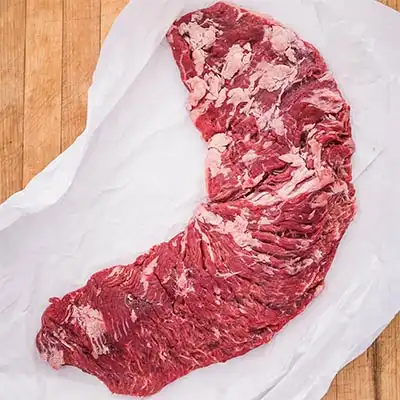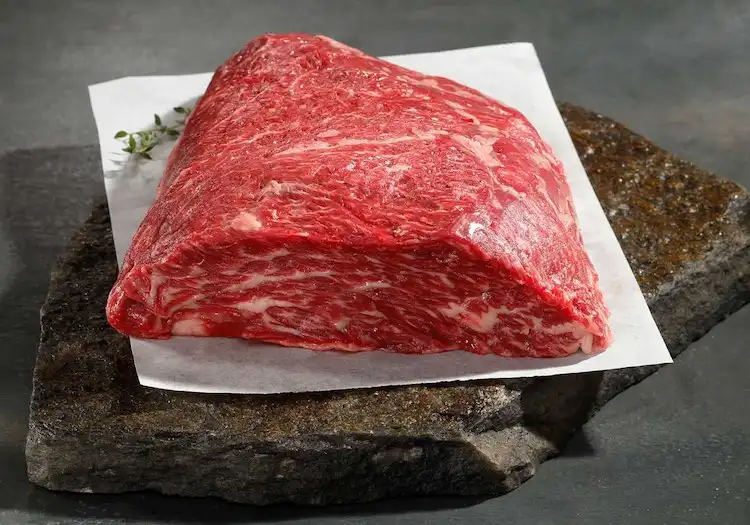The Bavette Steak: A Complete Cooking Guide

The Bavette steak is a surprisingly tender and flavorsome cut that is sometimes confused with the Skirt and Flank steaks and suffers from some genuinely terrible naming conventions.
With the Bavette becoming increasingly popular for its great taste and low price, we’ll bring you up to speed on where you can find this cut and the perfect way to prep and cook it.
What is Bavette steak?
Bavette is the French name for this cut and means ‘bib’, referencing its long, flat shape.
One of the reasons the Bavette didn’t make the transition from the butcher to the supermarket meat aisle is that its more common U.S. name, the Sirloin Flap, is one of the least appetizing names we’ve heard in a while.

The cut itself comes from the Sirloin Primal and is a close neighbor of the Flank steak, meaning the two often get confused. However, by comparison to the Flank and Skirt steaks, the Bavette is more tender and has better marbling.
The Bavette’s key characteristics are its strong beefy flavor and the loose and open structure of the meat. The combination of these factors lets the Bavette take on rich marinades while still contributing to the overall flavor profile of a dish.
Like the Flank steak, the Bavette has a coarse texture and the characteristic chew that is typical of the longer cuts from the Sirloin Primal. Poorly prepared, the Bavette, like the other Sirloin Primal steak cuts, quickly turns into boot leather. However, as you’ll see later, when cooked correctly, this cut is tender and juicy with a great meaty flavor.
Where to buy Bavette steak
Now you’ve got some idea of what a Bavette steak is and why it’s a hugely underrated cut of meat, let’s talk about where you can get one and how to store it.
While the growing popularity of the Bavette steak means it is showing up on certain supermarket shelves, there’s no guarantee that you’ll find it in your local meat aisle alongside the more well-known cuts.
Thankfully, your local butcher is almost sure to be able to provide you with a Bavette steak. However, since the average size of a Bavette cut is between two and four pounds per animal, you might want to phone ahead to avoid disappointment.
If you don’t have access to a reliable butcher, all is not lost. There are plenty of great places to buy your meat online, without companies like Snake River Farms and Porter Road able to send excellent quality meat directly to your doorstep.
One of the highlights of the Bavette steak is its rich beefy flavor, which can be further enhanced through aging. Dry-aged beef, hung for a minimum of 21 days to make it more tender and delicious, develops a deep red color you can look out for.
The Bavette steak is often confused with the Skirt and Flank steaks, which are similar but definitely not the same thing, so it’s worth taking the extra time to make sure what you’re buying is definitely a Bavette steak. Don’t be afraid to question your butcher.
The best way to cook Bavette steak
Once you’ve got your Bavette steak in hand, it’s time to cook it. While we’re not here to insist you cook your steaks in a certain way, we do have two methods to suggest that we think bring out the best in the Bavette.
Grilling it
The simple and easy option, the Bavette steak responds really well to hot and fast grilling in a heavy-bottomed pan or on the barbecue. The trick here is to cook the meat to the rare side of medium-rare, so let’s break it down into steps.
- If you have the time, prep your steak by salting it and leaving it uncovered in the refrigerator for 24 hours. This both thoroughly seasons the meat and dries out its surface.
- Heat a heavy-bottomed pan, like a cast-iron skillet, or your grill up to as hot as it will go. Add a small amount of neutral oil to stop the meat scorching.
- When it’s up to heat, add your steak and cook for two or three minutes each side, resisting the urge to press down on a steak or turn it constantly.
- Once cooked, rest your Bavette steak on a warm plate for up to 20 minutes before cutting across the grain to serve.
If you want to see cooking Bavette steak in aciton, this video from Cooking With Ry is a great watch.
Sous Vide
We’ve spoken before about the benefits of adding a sous vide to your BBQ tool kit, and its ability to cook a steak to perfect medium-rare works very well to get the best out of the Bavette steak.
- Season your Bavette steak and then seal it into a vacuum bag using your vacuum sealer.
- In a pot large enough to take your sealed steak without spilling water everywhere, set up your sous-vide machine and let it heat the water to a consistent 130°F (54°C).
- Immerse your sealed Bavette steak in the water for at least one hour and for up to four hours.
- Once cooked, remove the Bavette steak from the vacuum bag and let it rest for at least ten minutes. This reduces the meat’s temperature so it won’t overcook when we give it the final sear.
- While the meat is resting, bring a heavy-bottomed pan, like a cast-iron skillet, up to the highest heat you can get it and add a little neutral oil.
- Pat the surface of the meat dry and add it to the pan. Cook it for about 30 seconds to one minute per side for a deep crispy sear.
- Serve and eat immediately.
Bavette steak tips and FAQS
Since the Bavette steak isn’t a particularly well-known cut, most pitmasters won’t have the same familiarity with it as they do with cuts like the Ribeye or even Flank steak.
To help out, here are some answers to the most common questions on Bavette steak.
What dishes work best for Bavette steak?
Unlike the Flank or Skirt steak, the Bavette steak is tender enough to be eaten on its own. It works extremely well when cooked quickly and sliced as thinly as possible, making it great for steak sandwiches.
Bavette steak has a rich beefy flavor that makes it an excellent choice for enhancing dishes like stir-frys and bibimbap and an open grain that takes very well to marinades in dishes like fajitas.
We have a list of our favorite side dishes to serve with steak, that would give you lots of good ideas that would work for Bavette.
How to slice Bavette steak
Bavette steak is typified by its loose open structure and its visible grain. The ‘grain’ referred to in meat is the direction that the muscle fibers are aligned.
These muscle fibers are what impart a pleasant chew, when cooked properly, or an unpleasant leatheriness when overcooked. The shorter the fiber, the more tender the cut of meat is.
Slicing your steak using the sharpest knife you can find and making sure the cuts run perpendicular to the long parallel muscle fibers, which are thankfully obvious in a Bavette steak, will result in a more tender slice of meat.
While it is more tender and marbled that Flank or Skirt steak, Bavette steak doesn’t have that melt in the mouth tenderness you would associate with Filet Mignon, so it benefits from you keeping the slices as thin as possible.
Is Bavette steak healthy?
Comparatively, Bavette steak is one of the healthiest cuts of beef. This is because it comes from the relatively lean Sirloin Primal and has no external fat cap.
It does have more marbling than its close neighbors, the Flank and Skirt steak, which makes it better suited for being grilled or fried and eaten on its own, as the marbling helps to keep it tender.
If you’re looking to be extra healthy and are planning on adding beef to a stir fry or fajitas, you can always substitute Flank or Skirt for Bavette to cut down the fat as much as possible.
What is Wagyu Bavette steak?
Wagyu is a specific type of beef originating exclusively from Japanese Kuroge Washu cattle.
Most Wagyu beef is imported from Japan, although small numbers of Kuroge Washu cattle are raised in the U.S. and Australia, where they are commonly bred with Angus cattle to increase their yield. Kobe beef is a type of Wagyu that comes from animals raised explicitly in the Hyogo Prefecture in Japan.
Wagyu is prized for its intense marbling and rich umami flavor, and its export from Japan is heavily regulated, increasing its price.
Wagyu beef intensifies a Bavette steak’s positives, increasing both its marbling and its deep beefy flavor. The downside of this is that the combination of an unusual cut from a prized and heavily regulated type of premium beef can make Wagyu Bavette a little challenging to find.
Thankfully, companies like Snake River Farms are a great place to find both unusual cuts and American Wagyu. As a bonus, all their beef, including their Wagyu Bavette, is 100% natural with no added hormones.
Wrapping it all up
The Bavette steak is a versatile and delicious cut that doesn’t get the attention it deserves. Now that you’re in on the secret, however, you can enjoy this fantastic piece of meat either on its own or to add an extra depth of flavor to dishes like fajitas or stir fry.
Do you have a cooking method or recipe that you’ve found work amazingly with Bavette steak? We’d love to hear about it in the comments below!










